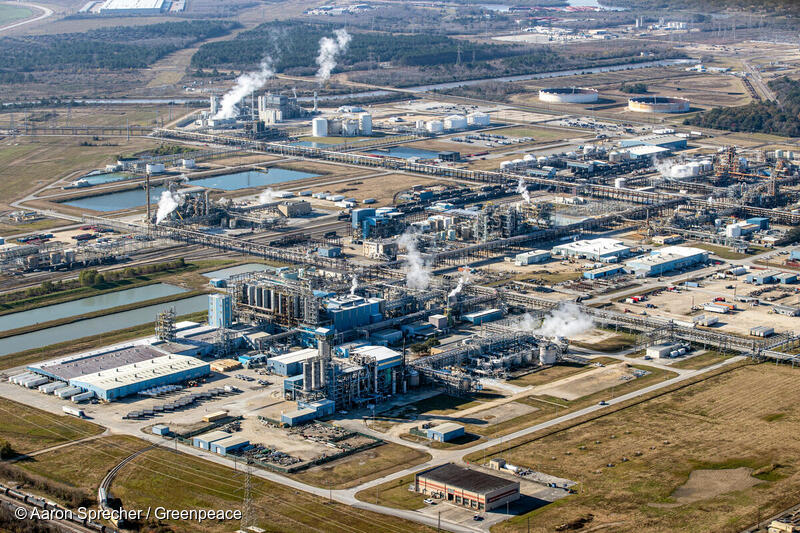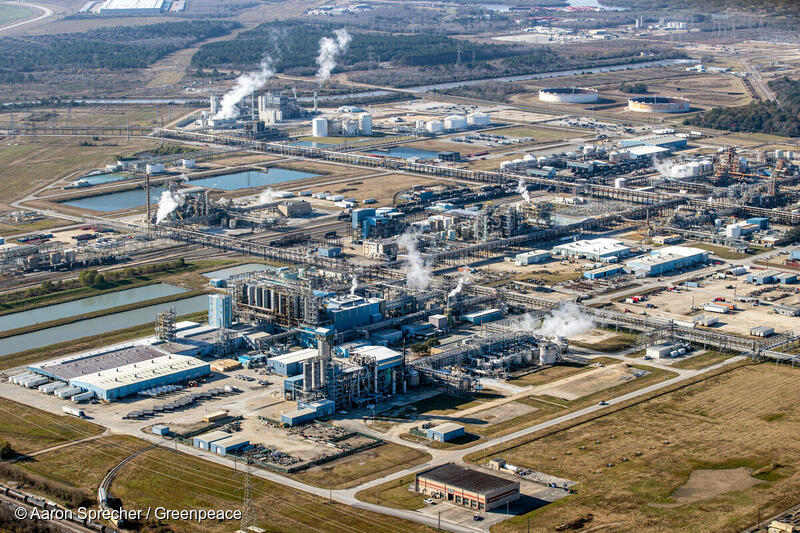Learn about the connections between single-use plastic, fossil fuels and the climate crisis

The Houston area has long been known as a major hub of the petrochemical and fossil fuel industry.

ChevronPhillips, Olefins refining facilities in Baytown, Texas.
The Houston area has long been known as a major hub of the petrochemical and fossil fuel industry.
How are single-use plastics linked to climate change?
- Nearly every piece of plastic begins as a fossil fuel [1], and greenhouse gases are emitted at nearly every stage of the plastic lifecycle: 1) fossil fuel extraction and transport, 2) plastic refining and manufacture, 3) managing plastic waste, and 4) plastic’s ongoing impact once it reaches our oceans, waterways, and landscape. [2]
- CIEL estimated that, in 2019 alone, the production and incineration of plastic products created greenhouse gas emissions equivalent to 189 coal-fired power plants. [3]
- If plastic production stays on its current business as usual trajectory, by 2030, CIEL estimates that the yearly greenhouse gas emissions from plastic could be equivalent to the emissions produced by 295 (500 megawatt) coal-fired power plants and by 2050, that could grow to the CO2 equivalent of 615 coal-fired power plants. [4]
- If we continue with business as usual then by 2050 plastic production could be eating up 13 percent of our carbon budget, and by 2100 emissions from plastics could compose at least half of the Earth’s carbon budget, according to a CIEL analysis. [5]
The oil industry is declining. What does that have to do with plastic demand?
- 99% of plastic is made from fossil fuels [6], and Big Oil is investing billions in plans to massively expand petrochemical (plastic) production to keep the fossil fuel industry afloat. [7]
If business as usual continues, industry estimates predict plastic production could double by 2030 and triple by 2050 in comparison to 2015. [8] - Industry has announced plans to invest $204 billion into new chemical and plastic production projects in the US over coming years, as part of a strategy to export chemicals and plastic globally. Industry data suggests that $96 billion had been spent by July 2020. [9]
What are the impacts of petrochemical and plastic production on human health?
- A 2018 study on a small residential cohort of 2,388 people suggests that older adults and females in Taiwan who live less than 6 miles from a petrochemical plant (and had been living in the same area for at least nine years) are more likely to be diagnosed with all types of cancers. [10]
- In the U.S., existing plastic production facilities and planned expansion are particularly disproportionately burdening Black, Brown and low-income communities. Studies have shown these communities face an increased risk and incidence of cancer and respiratory diseases like asthma. [11]
- A growing body of literature [12] suggests people living near facilities involved in oil and gas refining and drilling may be more susceptible to a number of toxins from sources including: air pollution, diesel particulates and airborne volatile organic compounds. Unwanted noise from drilling and construction and traffic may also add to psychological stress. [13]
- Studies have found increased incidences of disease or mortality associated with diseases when looking at communities adjacent to specific petrochemical facilities in the UK,[14] Serbia [15], and Spain [16].
Are big brands’ failure to invest in reuse and refill solutions driving increased plastic production?
- A 2020 review of action by big brands signed up to the Ellen McArthur Foundation Global Plastics Commitment found that plastic packaging use by signatories actually grew by 0.6% in 2019. It also found that in 2019 reusables accounted for just 1.9 per cent of packaging, up only 0.1% from a year earlier. A tiny increase despite the many reuse pilots we have seen being promoted. Just 17% of the problematic or unnecessary single-use items produced by signatories have successfully been eliminated. [17]
- Coca-Cola’s annual plastic production alone amounts to more than 100 billion bottles per year. [18]
- Nestle has committed to less than 1% reuse. Nestlé’s claim to make 100% of its packaging environmentally friendly is an empty promise, built on false solutions like ‘recyclability’ and shifting to other problematic packaging materials like paper. [19]
- Break Free from Plastic’s global brand audit found the top plastic polluters for three years in a row to be: Coca-Cola, Nestlé and Pepsi. [20]
Can recycling play a role in reducing demand for new single-use plastics made from fossil fuels?
- Plastic recycling is a false solution. It is estimated that of all the plastics ever produced (to 2015) only 9% were recycled, and with plastic production projected to increase in the years to come, we will never be able to solve this crisis with waste management and cleanups. Reduction and reuse and refill systems are crucial. [21]
Want to learn more and take action? Check out our Fighting Plastic Pollution page.
REFERENCES
[1] https://www.ciel.org/wp-content/uploads/2017/09/Fueling-Plastics-Fossils-Plastics-Petrochemical-Feedstocks.pdf
[2] https://www.ciel.org/wp-content/uploads/2019/05/Plastic-and-Climate-FINAL-2019.pdf
[3] https://www.ciel.org/plasticandclimate/
[4] EMF/WEF and CIEL analysis both come to this similar conclusion, using different estimates for various parts of their modeling. EMF/WEF estimate the growth: from 311 MT in 2014 to 1124 MT by 2050) – https://www.ciel.org/plasticandclimate/
[5] EMF/WEF and CIEL analysis both come to this similar conclusion, using different estimates for various parts of their modeling. EMF/WEF estimate the growth: from 311 MT in 2014 to 1124 MT by 2050) – https://www.ciel.org/plasticandclimate/
[6] https://www.ciel.org/wp-content/uploads/2017/09/Fueling-Plastics-Fossils-Plastics-Petrochemical-Feedstocks.pdf
[7] American Chemistry Council website, Accessed July 13, 2020. (CIEL reference (Fueling Plastics, Plastics and Climate), and stats from PlasticsEurope that bio-based plastic represents 1% of the plastic on the market). https://www.americanchemistry.com/Policy/Trade/US-Chemicals-Trade-by-the-Numbers.pdf also American Chemistry Council website, Accessed July 13, 2020. (CIEL reference (Fueling Plastics, Plastics and Climate), and stats from PlasticsEurope that bio-based plastic represents 1% of the plastic on the market).
[8] EMF/WEF and CIEL analysis both come to this similar conclusion, using different estimates for various parts of their modeling. EMF/WEF estimate the growth: from 311 MT in 2014 to 1124 MT by 2050) – https://www.ciel.org/plasticandclimate/
[9] American Chemistry Council website, Accessed July 13, 2020. (CIEL reference (Fueling Plastics, Plastics and Climate), and stats from PlasticsEurope that bio-based plastic represents 1% of the plastic on the market). https://www.americanchemistry.com/Policy/Trade/US-Chemicals-Trade-by-the-Numbers.pdf also American Chemistry Council website, Accessed July 13, 2020. (CIEL reference (Fueling Plastics, Plastics and Climate), and stats from PlasticsEurope that bio-based plastic represents 1% of the plastic on the market).
[10] https://www.sciencedirect.com/science/article/pii/S1438463917302912
[11] Overview of community and industry specific studies chronicled in Toxic Wastes and Race in the United States (UCC, 1987), Dumping in Dixie (Bullard, 1990), and Toxic Communities (Taylor, 2014).
[12] See, for example: Allshouse et al. Environ Sci Technol. 53, 7126–7135 (2019). DOI: 10.1021/acs.est.9b00052; Johnston et al. Sci Total Environ. 657, 187–99 (2019) DOI: 10.1016/j.scitotenv.2018.11.483.
[13] Richburg, C.M. & Slagley, J. Public Health Nurs. 36, 3–10 (2019). DOI: 10.1111/phn.12540
[14] Bhopal, et al. Occup. Environ. Med. 55, 812–822 (1998).; Sans et al. Occup. Environ. Med. 52, 217–224 (1995). doi: 10.1136/oem.52.4.217.;
[15] Relić et al. Molecules 24, 2139 (2019). DOI: 10.3390/molecules24112139
[16] Nadal et al. Chemosphere. 66, 267-276 (2007)
[17] https://ellenmacarthurfoundation.org/news/global-commitment-2020-progress-report-published
[18] https://www.theguardian.com/business/2019/mar/14/coca-cola-admits-it-produces-3m-tonnes-of-plastic-packaging-a-year also https://ellenmacarthurfoundation.org/news/global-commitment-2020-progress-report-published
[19] https://ellenmacarthurfoundation.org/news/global-commitment-2020-progress-report-published
[20] https://www.breakfreefromplastic.org/2020/12/02/top-plastic-polluters-of-2020/
[21] https://advances.sciencemag.org/content/3/7/e1700782
